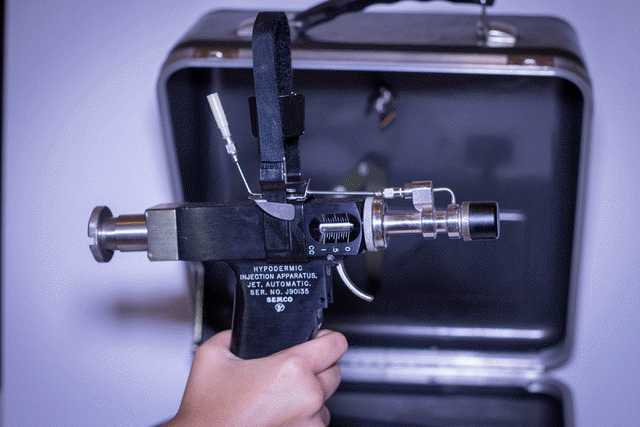|
|
|||||||||||||||||||||||||||||||
|
|
|||||||||||||||||||||||||||||||
|
THE GLOBE AND MAIL THURSDAY, FEBRUARY 27, 1975 Federal regulations violated Contamination problems danger of infection reported at Connaught A cardiac stimulant, Epinephrine, produced under conditions unacceptable to federal health inspectors is still being sold by Connaught Laboratories. Supplies came from inventory built up before the publicly financed Canada Development Corp. subsidiary stopped production of a number of drugs last summer after repeated complaints from federal authorities. Inspectors in February last year found Connaught had done nothing about infractions of health regulations reported more than a year earlier and that, in fact, the situation had become worse. In June, Ottawa's Advisory Board Manufacturing was demanding "significant improvements" in the quality of Connaught's operations. And in September, Dr. John Furesz, director of the bureau of biologics in Ottawa's health protection branch, inspected some parts of the Connaught operation. He found a number of problems. Among the most serious were the "grossly inadequate" quarters for control testing of Sabin polio vaccine. "As a result, occasionally control testing of more than one type of live vaccine is being done at the same time. No proper separation of tissue cultures was seen, giving rise to danger of cross-contamination. "Danger also exists of laboratory-acquired infection of the workers employed there," he reported. And yet, Donald McCaskill, Connaught president, had told The Globe and Mail in a December interview that the September inspection had found nothing seriously wrong. Recently, after releasing the inspection report, he said in defence of his earlier statement, "It's a clean bill certainly in that he didn't take the licence away, eh?" Mr. McCaskill also had said the drugs taken out of production last summer were dropped because they weren't worth the money needed to bring production up to federal standards. Report Critical Later, through a press relations firm, he said the action was taken because the drugs in question were low-volume items and Connaught had just a small share of the market and its staff could be better used on other projects. In three interviews in three weeks, Mr. McCaskill had denied that any federal officials ever expressed severe criticism of any Connaught facilities or practices. But. two weeks ago, he released the often critical September inspection report. And confronted with copies of 1974 letters from H.A. Showalter, drug boardchairman, he conceded that, among other things, Connaught’s vital blood plasma fractioning plant had failed to meet Government standards.He says he believes that it would pass inspection now. Last February he was told in a memorandum from one of his vice-presidents, S.R. McInnes, that $300,000 was needed immediately to renovate and expand the plant to comply with regulations. Mr. McInnes said the building probably "would be closed if it were subjected to an inspection." He said the work was needed "to reduce severe and costly contamination problems." Blood polluted Though he didn’t say so, it was costly not only to Connaught, which had become a profit-oriented operation since its CDC takeover, but also to Canada’s superior blood transfusion service. The Canadian Red Cross, its voluntary donor program envied around the world, wants to avoid the controversy but its officials don’t like what has been happening. The Red Cross ships all out-dated blood (whole blood lasts three weeks) to Canada’s only fractionation lab at Connaught where, it is broken down into a variety of life-saving fractions. The Red Cross buys some of these back for low-cost distribution to hospitals, which increasingly require blood fractions, often safer than whole blood transfusions. And fractionating makes one donation do the work of five or more. Mr. McInne’s memo about contamination problems lends support to what some are saying outside of Connaught - that as much as 50 per cent of the whole blood it receives never gets all the way through the fractionation production line because of contamination. Though they are backed by what international journals have lauded as one of the finest blood services in the world, Canadian hospitals have bought from private firms in the United States, and at higher prices because Connaught cannot keep up with the demand. However, a scientific review of operations last fall by Dr. Margaret Pittman, a prominent semi-retired U.S. biologist, said of the plasma operation the "the limited factor in production volume is source material ..." but that Connaught was planning new products and increased in efficiency. Mr. McCaskill had received another and much more critical assessment of the plasma operation from Dr. Andrew Moriarity, vice-president of Connlab Holdings Ltd., CDC’s health services division and owner of Connaught. Dr. Moriarity had put his assessment in memo form in the same month that his colleague, Mr. McInnes had called for the $300,000 for improvements.
Dr. Moriarity said any proposal to expand the existing plant would be a waste of money. Complete reconstruction, he said, was required. "Because of recent quality-control problems with certain of our plasma products" he wrote in his memorandum, "I have taken the opportunity to inspect the Connaught plant." "By almost any standard, this production unit is inadequate. Areas for quarantine, processing, cleaning, storage, etc., are inadequate and poorly segregated." "Flooring is old and worn and complicates any sanitation process, inadequate lighting and poor ventilation represent health hazards for the workers." "Crowding, exposed piping and peeling paint are not consistent with the standard of quality expected of Connaught. It is no wonder that contamination has been a recurring problem with our plasma products." He continued, "Certain improvements have recently been made but these are obviously of a makeshift nature. How this plant has passed inspection by the various regulatory agencies, I am at a loss to understand." Dr. Moriarity’s criticisms of Connaught operations extended to many other aspects including other production units and to management and its policies. They finally got him fired and after a wait of four months and word form colleagues that there had been no improvement, he took his allegations to federal authorities. Mr. McCaskill, who makes a blanket rejection of Dr. Moriarity’s complaints, said in a written statement in The Globe and Mail that at the time the plasma plant was inspected by federal officials in January 1973, it met the regulations. Many facilities were inspected at that time although not, he said, Connaught’s insulin plant. It had not been checked by the federal Health department since being built four years ago. However, Mr. McCaskill’s reference to a 1973 plasma plant inspection was in error, according to Rene Mercier, Ottawa Health Department spokesman. Saying that he could not explain the neglect, Mr. Mercier said the plant had not been inspected since March, 1969. After Globe and Mail inquiries this month, an inspection was conducted. The only other plasma-related inspection was early in 1971, when one facet of plasma production - in another building was checked. Penalty Threat Theoretically a drug producer found violating regulations may be suspended from doing business with governments, - Connaught’s biggest customers - for 90 days, and must correct the violations to win reinstatement. In January 1973, Connaught was found in breach of regulations governing the sensitive areas of raw material and packaging tests and product stability. Yet no punitive action was taken. And in February, 1974, there was another inspection. In May, Mr Showalter, the drug board chairman, wrote to Connaught chairman Dr. R. J. Wilson saying there were violations not only in the areas cited the year before, but also in the areas of finished product tests and quality control. In mid-June, Mr. Showalter wrote again, commenting on an intervening letter from Connaught, expressing a continuing disappointment and stating that the drug board "may be inclined to examine the next report very critically, unless significant improvement is shown. I have been requested to convey this to you in the clearest terms." The next report - as far as can be ascertained - was the one from Dr. Furesz last September and, again, along with some "very good" notations, were references to hazardous situations and violations of regulations. Favorable Study Mr. McCaskill conceded that the inspection did not include a look at the blood plant, and he did not know if it included other areas of concern raised by Mr. Showalter. Meanwhile, during the period of Government disclosures of inadequacies and threats and repeated threats that Connaught might be blacklisted, the very things the regulations are aimed at preventing are said to have taken place, including delivery of vaccines said to have been below proper potency. Dr. A.B. Morrison, assistant deputy minister in charge of the federal health protection branch, confirms that investigations have been started into the allegations made by Dr. Morairity. He said he could not discuss the nature or scope of the investigation because it was conceivable some people would be charged under the Canadian Food and Drug Act. Mr. McCaskill said in December that the study by Dr. Pittman, a 71 year old consultant on assignment for the World Health Organization, was to be an investigation of the validity of the Moriarity charges. Her 17 page preliminary report, he said, gave Connaught "a complete bill of health." However, he said, "compliance with Government regulations was not a specific part of Dr. Pittmans terms of reference," and he conceded, after reluctantly releasing a copy of her report, the study was not as thorough as he had first implied, nor was it directed to the specifics of Dr. Moriarity’s allegation." Good Products Dr Hilda MacMorise, head of Connaught’s human biologics, agreed that the report was somewhat superficial. And Dr. Pittman herself referred in a section assessing scientific resources to her "cursory observation." But generally she spoke of products being good or excellent and said quality control was satisfatory. In her brief concluson, Dr. Pittman wrote: Although going through an adjustment period, CLL is a viable oranization with potential of its mandate to manufacture products for national health care and for commercial mompetition "The production divisions are functioning relatively well. Some improvements were suggested ... a better understanding between financial management and scientists was indicated." |
|
Site Map
For problems or questions regarding
this Web site contact
|
|
|





